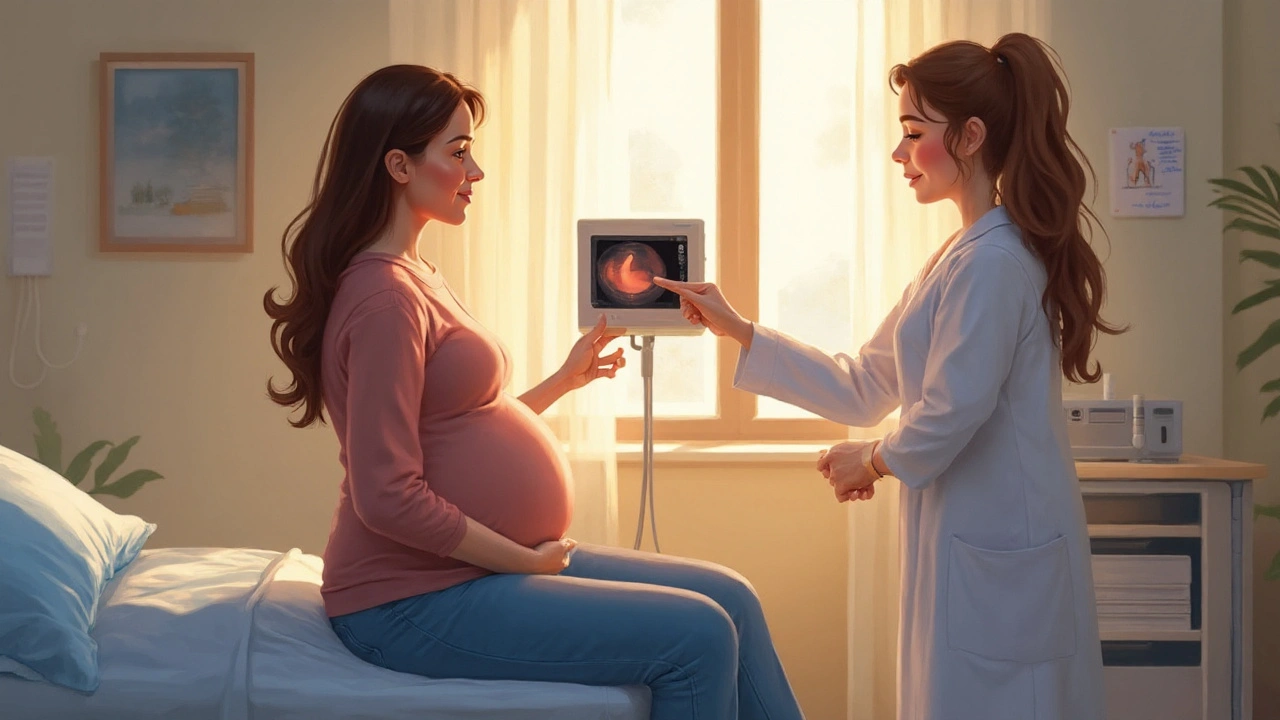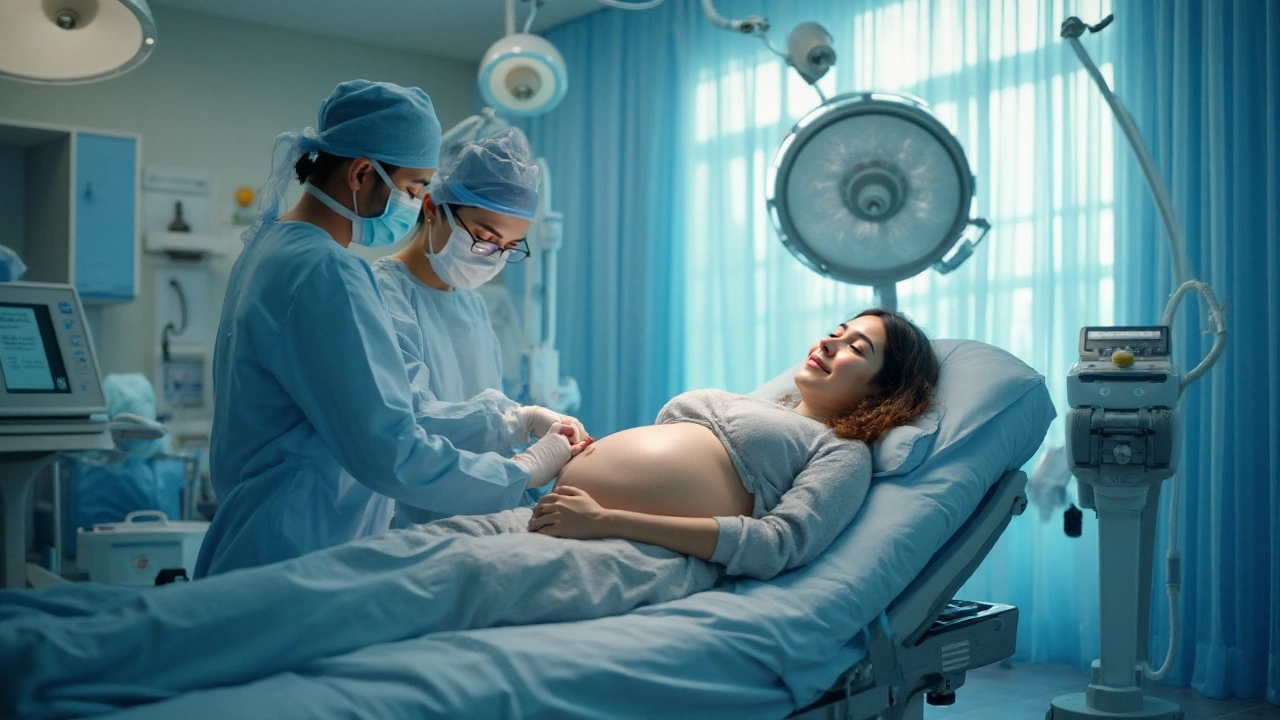Gallstones in Pregnancy - Risks, Complications & Treatments
 Aug, 18 2025
Aug, 18 2025
Gallstones during pregnancy is a medical condition where calcified particles form in the bile and lodge in the gallbladder while a woman is pregnant. Hormonal shifts, increased cholesterol, and slower gallbladder emptying make the pregnant body especially prone to stone formation. About 5‑8% of pregnant women develop symptomatic gallstones, and the timing of symptoms often aligns with the second or third trimester when hormone levels peak.
Why do gallstones appear in pregnancy?
The primary driver is the hormone progesterone. It relaxes smooth muscle, including the gallbladder wall, leading to reduced contractility and bile stasis. When bile remains static, cholesterol can become supersaturated, precipitating as stones. Bile itself is a mixture of cholesterol, bile salts, and bilirubin; any imbalance in these components can tip the scale toward crystallization.
Key risks and potential complications
Most gallstone episodes are mild, but a subset progresses to serious conditions that endanger both mother and baby. The most common complications are:
- Acute cholecystitis - inflammation of the gallbladder caused by a stone blocking the cystic duct. Symptoms include severe right‑upper‑quadrant pain, fever, and nausea.
- Choledocholithiasis - a stone migrates into the common bile duct, risking bile flow obstruction and jaundice.
- Pancreatitis - when a ductal stone irritates the pancreatic duct, leading to inflammation that can trigger preterm labor.
- Obstetric issues - uncontrolled pain or infection can stimulate uterine contractions, raising the risk of preterm birth.
Maternal obesity, rapid weight gain, and a family history of gallstones amplify these risks. According to a 2023 obstetrics review, women who develop cholecystitis in the third trimester have a 12% higher chance of delivering before 37 weeks.
Assessing severity: When to act?
Clinical evaluation hinges on three pillars: symptom intensity, laboratory markers, and imaging findings.
- Symptoms: Persistent pain (>6hours), fever >38°C, or vomiting warrants immediate attention.
- Lab tests: Elevated white‑blood‑cell count, bilirubin, or liver enzymes (ALT, AST, ALP) suggest infection or ductal obstruction.
- Imaging: Ultrasound is the first‑line tool; it visualizes stones, gallbladder wall thickening, and ductal dilation without radiation. If ultrasound is inconclusive, Magnetic resonance cholangiopancreatography (MRCP) offers a radiation‑free view of the biliary tree.
Based on these data, clinicians categorize cases as conservative (observation) or interventional (medication, endoscopy, or surgery).
Treatment options
Each option balances gestational safety, symptom relief, and risk of recurrence. Below is a quick‑look comparison.
| Option | Typical Trimester Use | Invasiveness | Success Rate (symptom relief) | Key Risks |
|---|---|---|---|---|
| Observation & diet | All | None | 30‑40% | Possible progression to cholecystitis |
| Ursodeoxycholic acid (UDCA) | 2nd‑3rd | Medication | 60‑70% | Rare GI upset, limited data on long‑term fetal impact |
| Endoscopic Retrograde Cholangiopancreatography (ERCP) | 2nd‑3rd (after 20wks) | Minimally invasive | 85‑95% | Radiation exposure (mitigated with shielding), pancreatitis |
| Laparoscopic cholecystectomy | 2nd‑early 3rd (after 12wks) | Surgical | 90‑98% | Preterm labor, anesthesia risks, wound infection |
Notice the stark jump in success rates once an active intervention is chosen. The goal is to pick the least risky option that still offers reliable relief.
Medication: Ursodeoxycholic acid (UDCA)
UDCA is a bile‑acid derivative that helps dissolve cholesterol stones and improves biliary flow. It is classified as Category B for pregnancy, meaning animal studies show no harm and limited human data exist. Typical dosing is 10‑15mg/kg daily, divided into two doses.
Clinical experience from a 2022 multicenter trial involving 312 pregnant women showed a 68% reduction in pain episodes and a 45% drop in hospital admissions compared with observation alone. Side‑effects are mild-mostly nausea or loose stools.

Endoscopic approach: ERCP
When a stone blocks the common bile duct, ERCP can extract it without open surgery. Modern protocols use lead‑free fluoroscopy or ultrasound guidance to keep fetal exposure under 0.5mGy, well below the 5mGy threshold deemed safe.
Success hinges on gestational age; after 20weeks the uterus offers enough space for safe positioning. A 2021 review reported a 92% stone‑clearance rate with a 2% incidence of post‑ERCP pancreatitis-similar to non‑pregnant populations.
Surgical option: Laparoscopic cholecystectomy
When stones cause recurrent cholecystitis or fail medical therapy, removing the gallbladder is definitive. Laparoscopy offers faster recovery, less pain, and lower infection rates than open surgery. The procedure is performed under general anesthesia, but anesthesiologists adjust drug dosages to maintain maternal oxygenation and uterine perfusion.
Data from a 2024 meta‑analysis of 1,857 cases showed a 94% maternal survival rate, a 96% fetal survival rate, and a mean delivery gestational age of 38weeks when surgery occurred in the second trimester. The third trimester carries a higher preterm‑birth risk, so surgeons aim for early‑second‑trimester interventions when feasible.
Practical care plan for expectant mothers
Whether you’re a first‑time mom or already have children, a clear roadmap helps you stay calm when symptoms arise.
- Monitor diet: Low‑fat, high‑fiber meals reduce bile saturation. Avoid rapid weight loss diets, which can exacerbate stone formation.
- Stay hydrated: Aim for 2‑3liters of water daily; adequate fluid keeps bile fluid.
- Promptly seek care if pain lasts longer than 6hours, is accompanied by fever, or if you notice yellowing of the skin.
- Discuss treatment preferences with your obstetrician and a gastroenterology‑surgery team. Understanding the risk‑benefit profile of UDCA, ERCP, and surgery empowers shared decision‑making.
- Plan delivery timing if surgery is required. Most clinicians schedule cholecystectomy in the 12‑24week window, then continue routine prenatal care.
By following these steps, many women navigate gallstone episodes without jeopardizing their pregnancy.
Related concepts to explore
Understanding gallstones in pregnancy opens doors to several adjacent topics that often appear in women's health literature:
- Pregnancy‑induced cholestasis - a liver disorder that can coexist with gallstones.
- Bariatric surgery timing - how prior weight‑loss procedures affect gallstone risk in future pregnancies.
- Fetal monitoring during maternal surgery - guidelines for intra‑operative ultrasound and cardiotocography.
- Post‑partum gallstone management - when to consider definitive surgery after delivery.
These topics provide a broader view of how the biliary system interacts with reproductive health.
Bottom line
If you’re pregnant and suspect gallstones, you’re not alone. The combination of hormonal changes and slowed gallbladder emptying creates a perfect storm, but modern medicine offers safe paths-ranging from low‑risk medication to minimally invasive endoscopy and, when necessary, laparoscopic removal. Talk early with your care team, keep an eye on symptoms, and follow a diet that eases bile flow. With the right plan, most women see relief while keeping their babies safe.

Frequently Asked Questions
Can gallstones cause preterm labor?
Severe pain, fever, or infection from gallstones can trigger uterine contractions, raising the chance of preterm labor. Managing the underlying biliary issue-through medication, ERCP, or timely surgery-greatly reduces that risk.
Is ultrasound safe for diagnosing gallstones when I’m pregnant?
Yes. Ultrasound uses sound waves, not ionising radiation, making it the preferred first‑line imaging tool throughout pregnancy. It reliably detects stones larger than 2mm and can assess inflammation.
What is the safest medication for gallstone pain during pregnancy?
Ursodeoxycholic acid (UDCA) is considered the safest pharmacologic option. It’s categorized as Pregnancy Category B and has been shown to dissolve cholesterol stones gradually while easing symptoms.
When is laparoscopic cholecystectomy recommended during pregnancy?
Surgery is usually advised in the second trimester (12‑24weeks) if gallstones cause recurrent cholecystitis, obstructive jaundice, or if medical therapy fails. This window balances fetal organ development and the mother’s surgical tolerance.
How does ERCP protect the fetus from radiation?
Clinicians use lead shielding over the abdomen, limit fluoroscopy time to seconds, and sometimes employ ultrasound‑guided ductal access. The cumulative fetal dose stays well below the 5mGy safety threshold.
Will gallstones go away after I give birth?
Hormonal changes that caused bile stasis usually reverse postpartum, and many women see a reduction in stone formation. However, existing stones often remain, so a post‑partum evaluation is recommended to decide on definitive treatment.
dan koz
September 23, 2025 AT 08:11Man, I had gallstones while pregnant and just rode it out with tea and ginger. No meds, no surgery. My doc was like 'just wait' and guess what? After birth, poof, gone. Sometimes nature knows best.
Katey Korzenietz
September 23, 2025 AT 14:56UDCA? Pfft. My OB gave me that and I still ended up in the ER. They should just do the surgery early if it's gonna be a problem. Why risk the baby with 'watch and wait' when we got laparoscopy? Lazy medicine.
Mindy Bilotta
September 24, 2025 AT 14:37Just wanted to say - if you're reading this and scared, you're not alone. I was 28 weeks, screaming in pain, thought I was losing the baby. Got UDCA, stayed hydrated, and 3 weeks later? Barely a twinge. You got this. 💪
Storz Vonderheide
September 25, 2025 AT 21:32As someone who grew up in Nigeria where access to ERCP or laparoscopy isn't guaranteed, I’ve seen moms suffer through this for weeks. In places like mine, diet and hydration aren't just advice - they're lifelines. I’m glad this post includes low-resource context even if it’s not explicit. Knowledge is power, even when tools aren't.
Also, shoutout to the team who wrote this - clear, compassionate, and culturally aware. Rare.
Ethan McIvor
September 27, 2025 AT 19:41It’s wild how pregnancy turns your body into a biochemical experiment you didn’t sign up for. Progesterone relaxes everything - even your gallbladder. It’s not a flaw, it’s an adaptation gone sideways. Maybe we shouldn’t pathologize it so fast. Maybe the body’s just trying to protect the baby by slowing things down… even if it backfires.
Maybe the real question isn’t 'how do we fix it?' but 'how do we honor the system while gently nudging it back?'
Just thinking out loud. 🌱
Michael Bene
September 29, 2025 AT 18:38Let’s be real - this whole 'UDCA is safe' thing is just pharma’s way of selling you a $300/month bottle so you don’t demand surgery. They don’t want you to know that cholecystectomy in the 2nd trimester is safer than letting you suffer for 6 months. And don’t get me started on 'low-fat diets' - like I’m gonna eat celery for 9 months while puking 24/7? Nah. This whole system is designed to make you feel guilty for wanting relief.
Also, why is ERCP only recommended after 20 weeks? Because the uterus is big enough to get out of the way? Not because it’s safer for the fetus. Just saying.
Brian Perry
September 30, 2025 AT 22:29Okay but like… did anyone else notice the table says 'Success Rate (symptom relief)' for observation is 30-40%? That’s basically flipping a coin. Why even call it a 'treatment'? It’s just hoping you don’t die. I’m gonna go with surgery. No cap.
Kevin Estrada
October 2, 2025 AT 13:28THEY'RE HIDING SOMETHING. Why is there no data on long-term fetal effects of UDCA? Why is the 'safe' radiation dose for ERCP 5mGy but they don't show you the cumulative exposure from 3 ultrasounds + ERCP + follow-ups? It's all smoke and mirrors. I'm 32 weeks and I'm not touching any of this. I'm drinking apple cider vinegar and praying. #GallstoneConspiracy
Paul Corcoran
October 3, 2025 AT 23:57Hey everyone - I’m a nurse in Ohio and I’ve seen hundreds of pregnant women go through this. The fear is real. But so is the hope. UDCA works for most. ERCP is way safer than people think. Surgery in the 2nd trimester? Routine. You’re not alone. Talk to your team. Ask questions. You deserve relief without guilt. You’re doing great. 💛
Chris Jahmil Ignacio
October 4, 2025 AT 23:37Look at this article. All this 'science' - but no one talks about the real cause: processed foods and corporate sugar lobbying. The food industry made our bile thick. The medical industry made us dependent on pills and procedures. The government won't regulate sugar because it's profitable. Gallstones in pregnancy? It's not biology. It's capitalism. And they want you to think it's just 'hormones' so you don't revolt. Wake up.
Stop eating bread. Stop drinking soda. Eat meat. Eat fat. Eat real food. Your gallbladder will thank you. And your baby will be fine. The system doesn't want you to know this.